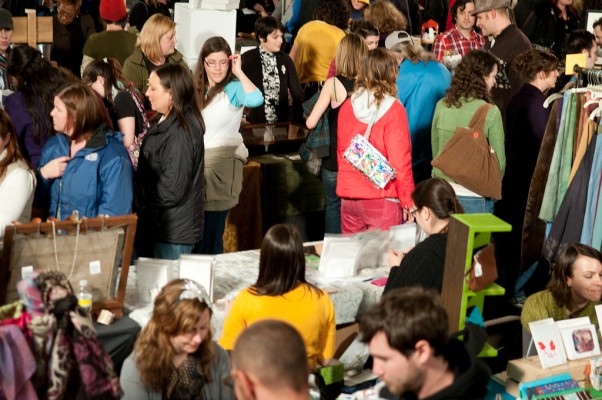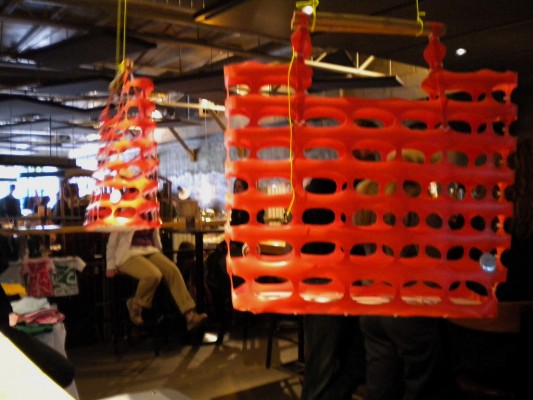So you just got accepted to your first craft fair — or maybe you’re looking to get serious about your craft show sales — here are some tips and tricks we’ve picked up over the years that can help you make the most of your craft fair experience.
Craft show basics
There are a few tried and true items that will set you up for a successful craft show. Among them are:
- A nice fabric tablecloth of some sort.
- A garbage bag to keep your world clean.
- A notepad and pencil to write down sales. Besides bragging rights and inventory, you’ll need to know how much you made to pay your taxes.
- Your vendor license and any other official documents the show requires.
- Lots of change. You can really never have too much, especially if an ATM is on site spitting out tons of twenties.
Show sanity savers
These items are also must haves:
- An “emergency kit” — scissors, markers, tape, string, safety pins, glue, etc. Handmade Detroit always keeps a ton of stuff in our emergency kit when we produce an event — and at some point, we always have everything checked out. You can’t always rely on organizers to have extra safety pins, so throw some supplies in a zippy — it could save your day.
- If you are allowed to bring food, make sure to pack protein and water — both can prevent a mid-day meltdown.
- A helper. Even if it’s just for an hour, a booth helper — someone who can help you sell — can be a tremendous sanity saver. Anticipate that you may be slammed with sales and unable to leave your booth to eat — this will let you get a little break, get something to drink, use the bathroom and take in the rest of the fair.
Table display ideas
- Although it’s not just a display idea, one thing you should be thinking about is having a highly edited product lineup. If you primarily make jewelry but also happen to make baby hats, consider leaving the latter at home. Having an instantly recognizable product line helps bring people into your booth and know what you sell — and that sticks with them after the fair is over, too.
- Speaking of which, if you have a product that’s a little hard to figure out what it does/how it works/what makes it super cool, consider adding some small signs to your display to explain. Or at least have a little talking point about what it does/how it works/what makes it super cool ready for when someone picks up your whirllymcbob and stares blankly.
- Everyone always says to “think vertical” with your displays, but I’d like to add that you should also think about not overwhelming your customers with too much stuff. Remember that study which said too much choice is paralyzing? Same works for craft shows. If you jam 523 things into a 3 by 3 space, your customers won’t know what to look at and will leave feeling overwhelmed. Extra multiples of things can be stuck behind your table — if someone really doesn’t see the light magenta/lavender in small that they were hoping for, it can always be brought out. Just make sure to have enough on your table to show variety. For my notebooks — which come in tons of colors — I try to keep about 30-40 out in a variety of colors and fill in as they are sold.
- A clearly printed company sign, placed in a well-positioned area is a must. My first year of craft shows, people always asked me “What’s your company name?” I quickly learned that an easy-to-read sign, placed in a prominent location does wonders in helping people walk away remembering your name — especially if your moniker is something unique.
- Leave space for your business cards and other show announcements in a prominent position as well.
Making a craft show sale (and many more)
- First, the basics: Smile and be nice. Greet anyone who comes into your area. Sometimes just talking to someone, telling them about your work and yourself can lead to a sale.
- On that note, don’t bring a book or involved project to work on. It discourages interaction — and you’ll need interaction to make transactions. (“Interaction leads to transactions” is my new motto!)
- Take credit cards, take credit cards, take credit cards. I can’t stress this one enough. As the day wears on, people will run out of cash, and so will the ATM. I have walked away from booths empty handed because they didn’t take cards. There are so many options for taking them, many of which are affordable, that there is no excuse not to get set up to take credit cards.
- Think post-show sales. This is where you really need to think about not only marketing materials like business cards, but also making a connection. Just because you’re one table in big show doesn’t mean that customer service matters any less. If you treat your customers well, are friendly, and just happen to mention that you’ve got an Etsy/take custom orders/would love to come to their knitting night, it can lead to repeat customers — and more sales in future shows when people begin to come to every show just to buy from you (yes, this does happen).
I’m sure you’ve also got a tip or trick that helps you make the best of a fair — please post in them in the comments.



